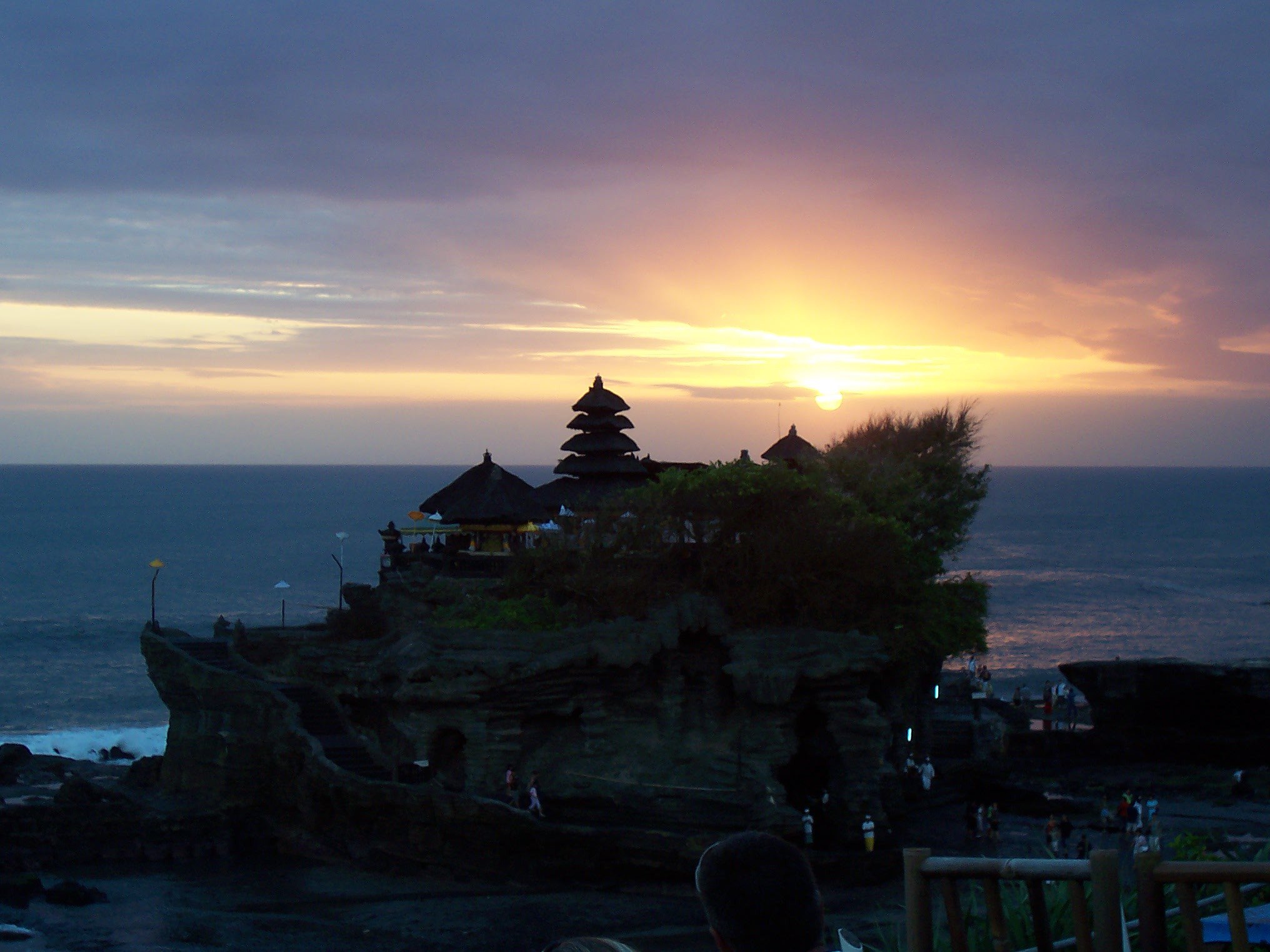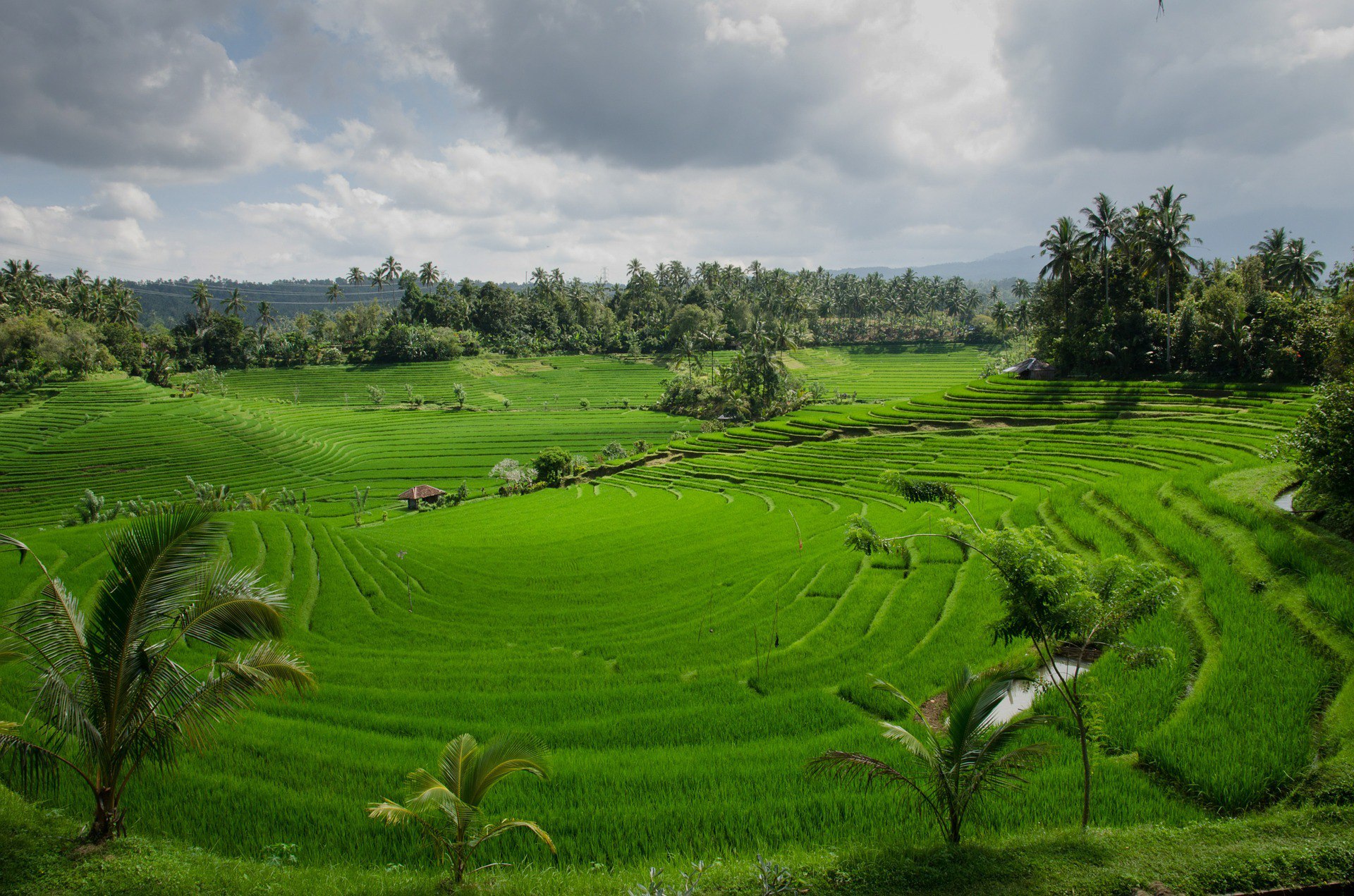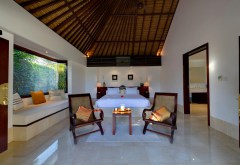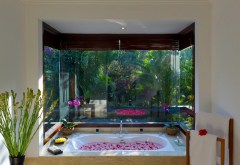Availability
We are sorry, this accommodation is not available to book at the moment
General
Villa Kailasha
3 Bedroom from USD 390++ per night
Villa Kailasha is a good choice for accommodation when comes to Bali. Villa Kailasha, meaning Paradise of the Gods, Villa Kailasha rests upon an expansive beachside retreat in Bali’s fertile Tabanan regency. The spacious pavilion, superb dining pavilion and separate dining terrace are all open to gentle breezes and dramatic ocean views. Guests can expect a relaxing, pampering and enjoy holiday at Villa Kailasha while listening to the soothing sound of the ocean waves.
Villa Kailasha three bedroom and an attractive design architecture with modern comforts and a dash of Dutch-colonial style, beautiful lush gardens and infinity edged swimming pool bordered by a checkerboard stone and grass terrace with a relaxation bale and a yoga deck to one side, comfortable and modern facilities and incredible amount of private space, and comfortable interiors.
The villa offers a variety of services, including private check in and check out, express check-in and check-out, free Wifi in all rooms, Wifi in public areas, car park and complemented by a full team of caring staff who will attend to every needs.
LOCATION
The Distance to the airport is 20km abaout 1 hour 10 minutes.
Villa Kailasha is situated a mere three-minute-stroll from Kelating Beach with its sparkling black sands and sweeping coastline views. The neighbourhood is the small Balinese village of Dukuh, which is bordered by rice fields for almost as far as the eye can see. A long way out of town, there are no restaurants, bars or shops here apart from the five-star Alila Villas Soori (300m) with its fine-dining restaurant and alfresco bar serving beachfront cocktails – especially good at sunset. The lonely beach and river estuary offers beautiful walks, and local temple ceremonies are a common sight; this stretch of coastline is popular with surfers but there are strong rip currents and no lifeguards so it is unsafe for swimming.
VILLA LAYOUT
INDOOR LIVING
– Fan-cooled open-air living pavilion rolls onto the garden featuring three distinct sitting areas, a large flat-screen TV and a partially sheltered stone terrace.
– The dining pavilion is open from three sides under a soaring roof, cooled by ceiling fans, with two tables, which, together, seat ten people
– Separate alfresco dining area seating eight – perfect for a BBQ
– Self-contained ‘butler’ kitchen in addition to the main kitchen which is fully fitted with professional equipment
OUTDOOR LIVING
– 11,000 square metres of land featuring beautifully manicured terraced lawns
– Infinity-edge swimming pool bordered by grass and paving and furnished with sun loungers and umbrellas
– Poolside balé relaxation pavilion containing lounges, coffee table and chairs
Quick Facts
LOCATION: Br. Dukuh, Tabanan, Bali, Indonesia.
CAPACITY: 6 people (1 master suite with king-size bed and 2 ensuite bedrooms with king-size beds). 3 extra beds may be set up on request at additional charge.
POOL: Main pool: 14m x 7m x 1.5m; Plunge pool: 6m x 4m x 1.5m.
LIVING AREAS: Living pavilion; dining pavilion; outdoor dining for 8; poolside balé.
STAFF: Villa staff team includes a part-time manager, cook, butler, housekeeping and security. Additional staff (eg babysitters, masseuses, driver, yoga instructor) available on request on extra cost.
DINING: A suggestion menu of Western, Asian, vegetarian and children’s dishes. Requests accommodated (including special diets). Grocery cost is charged 20% handling fee which is subject to service and tax at the prevailing rate.
COMMUNICATION: Complimentary WiFi broadband internet access throughout; telephone for local and international calls (charged to guest).
ENTERTAINMENT: 4 satellite TVs; DVD Player; iPod dock; Stereo system with CD player.
TRANSPORT: Car and driver available for 8 hours at a special rate of USD35++/day (excluding petrol).
EVENTS & WEDDINGS: Capacity up to 150 people can be arranged at the villa with prior notice.
ADDITIONAL FACILITIES: Barbecue; safety deposit box; in-villa spa and beauty treatments; full back-up diesel powered generator.
PROPERTY AREA: 10,125 sqm (land).
Check-in time
Check-out time
Check-in time
Check-out time
Facilities
- Air Condition
- Butler Service
- Dining room
- DVD player
- Free WiFi / Internet
- Garden
- In room: Free toiletries
- In room: Hairdryer
- In room: Minibar
- In room: Safety Deposit Box
- In room: TV
- iPod station
- Outdoor pool
- Parking area
- Private bathroom
- Private kitchen
- Seating area
- Sun chairs
We are sorry, there are no reviews yet for this accommodation.
Tanah Lot / Tabanan

Tanah Lot / Tabanan
Tabanan is a regency of Bali, Indonesia. It has an area of 839.33 km2 and population of 386,850 (2000), rising to 420,913 in 2010 Census. Its regency seat is Tabanan. Tanah Lot is in Tabanan.
Tabanan regency, which is known as Bali’s ‘rice bowl’ due to its vast terraced rice fields. This quaint village bordering a river is a rare example of a traditional Balinese community barely touched by tourism and the rapid development to the south of the island.
Tanah Lot means “Land Sea” in the Balinese language. Located in Tabanan, about 20 kilometres (12 mi) from Denpasar, the Tanah Lot temple sits on a large offshore rock which has been shaped continuously over the years by the ocean tide. Tanah Lot Temple (also called Pura Tanah Lot) is claimed to be the work of the 16th-century Dang Hyang Nirartha. During his travels along the south coast he saw the rock-island’s beautiful setting and rested there. Some fishermen saw him, and bought him gifts. Nirartha then spent the night on the little island. Later he spoke to the fishermen and told them to build a shrine on the rock, for he felt it to be a holy place to worship the Balinese sea gods. The main deity of the temple is Dewa Baruna or Bhatara Segara, who is the sea god or sea power and these days, Nirartha is also worshipped here.[4]
The Tanah Lot temple was built and has been a part of Balinese mythology for centuries. The temple is one of seven sea temples around the Balinese coast. Each of the sea temples was established within eyesight of the next to form a chain along the south-western coast. In addition to Balinese mythology, the temple was significantly influenced by Hinduism.
At the base of the rocky island, venomous sea snakes are believed to guard the temple from evil spirits and intruders. The temple is purportedly protected by a giant snake, which was created from Nirartha’s selendang (a type of sash) when he established the island.
The area leading to Tanah Lot is highly commercialized and people are required to pay to enter the area. To reach the temple, visitors must walk through a set of Balinese market-format souvenir shops which cover each side of the path down to the sea. On the mainland clifftops, restaurants have also been provided for tourists.
Jatiluwih village in Penebel District, north of Tabanan, has paddy fields following the contours of terraced land against the background of spellbinding Mount Batukaru and Mount Agung use traditional Balinese irrigation known as subak, Bali’s community-based water control management system. Lies at an altitude of 700 meters, the cool atmosphere of more original beautiful Jatiluwih is better than the most well known Tegallalang which has plenty of cafes and souvenir shops. Two routes to Jatiluwih are Denpasar>Kediri>Tabanan>Penebel>Jatiluwih or Denpasar>Mengwi>Baturiti>Jatiluwih. Jatiluwih has gain acknowledgement from UNESCO as part of the world’s cultural heritage
Tanah Lot is conveniently located en route for those moving to or from West Bali. A drive back to Kuta, Legian or Seminyak in the evening after sunset will take about 45 minutes to 1 hour depending on traffic.
Tanah Lot Map & Hotels:
[tp_hotelmap_widget coordinates="-8.6188, 115.0883" width=600 height=500 zoom=12 subid=""]
Attractions
 A visit to Tanah Lot for sunset is one of the most popular organised tours offered in Bali.
The Tanah Lot temple was built and has been a part of Balinese mythology for centuries. The temple is one of seven sea temples around the Balinese coast. Each of the sea temples was established within eyesight of the next to form a chain along the south-western coast. In addition to Balinese mythology, the temple was significantly influenced by Hinduism.
At the base of the rocky island, venomous sea snakes are believed to guard the temple from evil spirits and intruders. The temple is purportedly protected by a giant snake, which was created from Nirartha's selendang (a type of sash) when he established the island.
Tanah Lot is claimed to be the work of the 16th-century Dang Hyang Nirartha. During his travels along the south coast he saw the rock-island's beautiful setting and rested there. Some fishermen saw him, and bought him gifts. Nirartha then spent the night on the little island. Later he spoke to the fishermen and told them to build a shrine on the rock, for he felt it to be a holy place to worship the Balinese sea gods. The main deity of the temple is Dewa Baruna or Bhatara Segara, who is the sea god or sea power and these days, Nirartha is also worshipped here.
A visit to Tanah Lot for sunset is one of the most popular organised tours offered in Bali.
The Tanah Lot temple was built and has been a part of Balinese mythology for centuries. The temple is one of seven sea temples around the Balinese coast. Each of the sea temples was established within eyesight of the next to form a chain along the south-western coast. In addition to Balinese mythology, the temple was significantly influenced by Hinduism.
At the base of the rocky island, venomous sea snakes are believed to guard the temple from evil spirits and intruders. The temple is purportedly protected by a giant snake, which was created from Nirartha's selendang (a type of sash) when he established the island.
Tanah Lot is claimed to be the work of the 16th-century Dang Hyang Nirartha. During his travels along the south coast he saw the rock-island's beautiful setting and rested there. Some fishermen saw him, and bought him gifts. Nirartha then spent the night on the little island. Later he spoke to the fishermen and told them to build a shrine on the rock, for he felt it to be a holy place to worship the Balinese sea gods. The main deity of the temple is Dewa Baruna or Bhatara Segara, who is the sea god or sea power and these days, Nirartha is also worshipped here.
Jatiluwih village in Penebel District, north of Tabanan, has paddy fields following the contours of terraced land against the background of spellbinding Mount Batukaru and Mount Agung use traditional Balinese irrigation known as subak, Bali's community-based water control management system. Lies at an altitude of 700 meters, the cool atmosphere of more original beautiful Jatiluwih is better than the most well known Tegallalang which has plenty of cafes and souvenir shops. Two routes to Jatiluwih are Denpasar>Kediri>Tabanan>Penebel>Jatiluwih or Denpasar>Mengwi>Baturiti>Jatiluwih. Jatiluwih has gain acknowledgement from UNESCO as part of the world's cultural heritage.
Things to do:
 Just 3 kilometres fom the Tanah Lot Temple is the award-winning Greg Norman-designed Nirwana Bali Golf Course.
Just 3 kilometres fom the Tanah Lot Temple is the award-winning Greg Norman-designed Nirwana Bali Golf Course. The nearest surf beaches, including Echo Beach, are about eight kilometres from the temple and famous for surfing and spectacular sunsets.
Pejaten village is the centre of the ceramics manufacturing business in Bali, and well worth a visit. About 7 km north from Tanah Lot temple.
Rice paddys: 70 percent had to be left naturally as paddy field or plantation. The administration has also decided 300-hectare protected paddy field zone with a 100-hectare housing zone lies outside the protected zone.
Restaurants
There are large number of restaurants along the cliff top which offer great views but less great food. The best advice here would be to order a drink, get your fill of the views and photo-ops, and eat elsewhere.Read more








